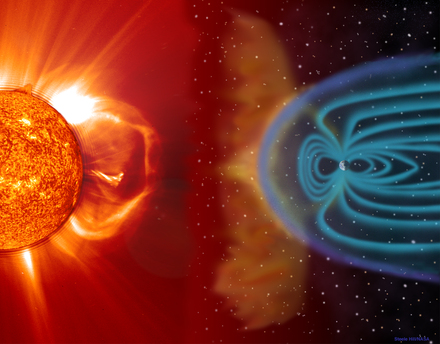Flickering Ghosts
Why is the sky alight?
 © NASA/ESA |
The schematic diagram shows how the solar wind meets the Earth's magnetic field and partially enters the Earth's atmosphere. The shower of particles there causes oxygen and nitrogen to glow.
The solar wind causes the Earth's sky to light up.
However, if the solar wind is especially strong the particles can penetrate our atmosphere, in particular in the polar regions, where the magnetic field meets the Earth's surface at right angles. The shower of particles there causes air molecules to glow: highly excited oxygen atoms at a height of around 60 miles emit green light and red light originates from oxygen atoms at a height of around 120 miles. Very large amounts of energy are necessary to excite nitrogen atoms, which then emit light that is violet to blue in color.
In mid-latitude regions, including most of Europe, auroras are unusual events. They usually have a red color here, as only rarely can the solar wind penetrate more deeply inside the atmosphere.
German Aerospace Center
Flickering Ghosts
Why is the sky alight?
 © NASA/ESA |
The schematic diagram shows how the solar wind meets the Earth's magnetic field and partially enters the Earth's atmosphere. The shower of particles there causes oxygen and nitrogen to glow.
The solar wind causes the Earth's sky to light up.
However, if the solar wind is especially strong the particles can penetrate our atmosphere, in particular in the polar regions, where the magnetic field meets the Earth's surface at right angles. The shower of particles there causes air molecules to glow: highly excited oxygen atoms at a height of around 60 miles emit green light and red light originates from oxygen atoms at a height of around 120 miles. Very large amounts of energy are necessary to excite nitrogen atoms, which then emit light that is violet to blue in color.
In mid-latitude regions, including most of Europe, auroras are unusual events. They usually have a red color here, as only rarely can the solar wind penetrate more deeply inside the atmosphere.
German Aerospace Center





